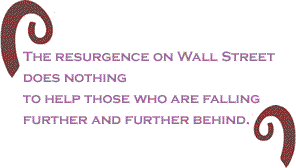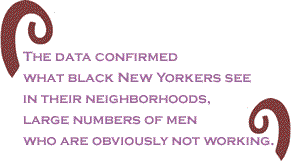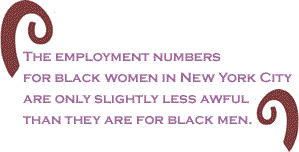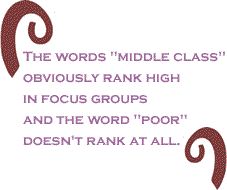
It
is rare for every publication in New York City to give equal
attention to the same
news story. A report issued recently by the Community Service
Society of New York accomplished that rare feat. The think
tank and social
service agency issued a report, "A
Crisis of Black Male Employment: Unemployment and Joblessness
in New York City, 2003." The data generated headlines
in the New York Times and the New York Amsterdam News because
it
revealed
the sobering information that only 51.8 percent of black males
in New York City between the ages of 16 and 64 are working.
The realization that the recession had such a terrible impact
on one group was stunning news. The data confirmed what black
New
Yorkers see in their neighborhoods:
large numbers of men who are obviously not working. Report author Mark Levitan
says that the response reflected a grim satisfaction that there is data to
back up what so many see every day. Over and over Mr.
Levitan was told, "Finally somebody put a number on something we've
known all along."
Behind those figures are devastated lives and devastated neighborhoods. The negative
impact of a nearly 50% rate of joblessness cannot be over emphasized. However,
statistics are useless without a context. How do these figures compare to other
groups and how does it compare to employment rates for black women?

As usual white men are at the top of the heap. Seventy-five
percent of them are employed. The same study showed that
57.1 percent of black women in New York
City are employed, which means that 42 percent of black women are not
working. The employment numbers for black women in New York City
are only slightly
less awful than they are for black men, 5.3 percent less
awful, to be exact.
It is unfortunate that the employment figures for black women
received less attention. There is little reason for rejoicing
if 42 percent
of black women
in the nation's
largest city are not working. According to Mark Levitan, the more muted
reaction to high unemployment for black women may be a result of
the relative success
in black women's economic fortunes as opposed to those of black men. "It's
not great but in a broader context black women are doing pretty well,
relative to history, not relative to where they should be."

It is too overwhelming to contemplate where black people should
be. Neither black men nor women are even close to white men
in their prospects
for employment.
We are relieved because black women have a few more crumbs than they
did in the past and yet we are fearful because black men
have even fewer.
 As
the report demonstrates, recessions hit men harder because they
tend to be employed in industries that sell goods instead of industries
that sell services,
which have more female employees. In addition, the employment gap between
all American men and women has been narrowing as more women become
lifelong workers.
These assertions are altogether believable, but the continued low rates
of employment for black men leads to the inescapable conclusion
that they are the least desired
as employees. In 2000 when the economic boom was at its height in New
York, 64% of black men were employed. It is not good news when
an economic
boom leaves
36% of black men outside of the work force. As
the report demonstrates, recessions hit men harder because they
tend to be employed in industries that sell goods instead of industries
that sell services,
which have more female employees. In addition, the employment gap between
all American men and women has been narrowing as more women become
lifelong workers.
These assertions are altogether believable, but the continued low rates
of employment for black men leads to the inescapable conclusion
that they are the least desired
as employees. In 2000 when the economic boom was at its height in New
York, 64% of black men were employed. It is not good news when
an economic
boom leaves
36% of black men outside of the work force.
The struggles of the unemployed and underemployed are off the radar
screen in public discourse. The results of the Community Service
Society study would not
have been so shocking if the very existence of the chronically unemployed
and underemployed were discussed more often. In this presidential
election year the
Democratic nominee, Senator John
Kerry, speaks only of protecting middle class jobs. Apparently
the conventional wisdom still holds. Acknowledging the existence
of poverty
in America is
the third rail of politics, unless the goal is to punish and demonize
through welfare "reform" and
three-strikes-your-out prison sentences. 
White collar jobs lost through outsourcing are consistently
reported. The loss of blue collar jobs has never been taken
seriously. There
is only rationalization
of cost cutting measures and the need to keep pace with foreign competition.
The reaction to computer programmers, attorneys and physicians losing
jobs to Indians elicits outrage and calls for boycotts. The
reactions are
appropriate
but should not be reserved for white collar workers alone.
If even Democrats won't discuss chronic joblessness the poor
are in a tough situation
indeed. The words "middle class" obviously rank high in focus groups
and the word "poor" doesn't rank at all. The Democratic
motto seems to be that a narrower base is best. Of course, fleeing
from a natural
constituency
always backfires. Democrats wax apoplectic about the prospect of
Ralph Nader taking votes from John Kerry. Perhaps Kerry shouldn't
ignore progressive
concerns regarding unemployment and other issues. Nader would be
a footnote in history
books if Democrats didn't expect to win while ignoring the needs
and concerns
of millions of Americans.
The Community Service Society is to be commended for putting numbers
to the nameless faces seen on New York's streets. Unfortunately,
their words may fall on deaf
ears. The resurgence on Wall Street does nothing to help those
who are falling further and further behind. Republican Mayor Michael
Bloomberg
is pushing plans
to build stadiums for the NFL Jets and the NBA Nets, projects that
will do little to help the low skilled unemployed. It seems that the
only ones
paying attention
to news of unemployment are those who knew about it all along.
Margaret
Kimberley’s Freedom Rider column appears weekly in  . Ms.
Kimberley is a freelance writer living in New York City. She
can be reached via e-Mail at [email protected]. You can read more
of Ms. Kimberley's writings at http://freedomrider.blogspot.com/ . Ms.
Kimberley is a freelance writer living in New York City. She
can be reached via e-Mail at [email protected]. You can read more
of Ms. Kimberley's writings at http://freedomrider.blogspot.com/ |






























